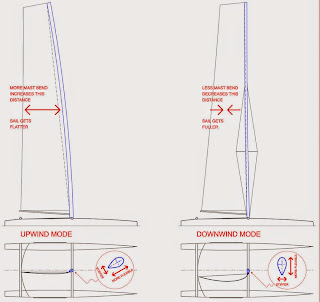Key dimensions
Length: 5.49m (18’)
Beam: 2.3m (7’ 6½”)
Weight fully rigged: 75Kg (165lb)
Sail area: 13.94m2 (150ft2)
Crew: One person
Rig and power management
Though relatively narrow for a catamaran, righting moment is good thanks to the skipper being on trapeze.
The wide staying base and lack of a jib (no need for great forestay tension) result in low stay tension/mast compression. This allows the use of streamlined masts that rotate about the vertical axis, reducing aerodynamic drag and increasing sail efficiency.
Masts have evolved to interact with the fully battened square top sails in sophisticated ways: Fibre distribution in the carbon spar is tuned to optimise bend properties with these interactions in mind.
The current generation of masts is more flexible across the long (fore/aft) axis than in the short (port/starboard) axis of the cross-section.
They can be set up to flex significantly under mainsheet and downhaul (Cunningham) tension going upwind, when the long/soft axis is closely aligned with the centreline of the boat.
Downwind, when the mast is rotated approaching 90 degrees (so the long/soft axis is across the boat), and mainsheet and downhaul tension are less, the mast remains straighter, making the sail deeper.
The deeper sail allows an increased lift coefficient. This is important for downwind sailing since sail area cannot be increased.
The current generation of masts is more flexible across the long (fore/aft) axis than in the short (port/starboard) axis of the cross-section.
They can be set up to flex significantly under mainsheet and downhaul (Cunningham) tension going upwind, when the long/soft axis is closely aligned with the centreline of the boat.
Downwind, when the mast is rotated approaching 90 degrees (so the long/soft axis is across the boat), and mainsheet and downhaul tension are less, the mast remains straighter, making the sail deeper.
The deeper sail allows an increased lift coefficient. This is important for downwind sailing since sail area cannot be increased.
In other words, the upwind/downwind transition involves altering the lift coefficient of the rig rather than the sail area.
In contrast to boats where additional sail area can be hoisted downwind, the A cat single sail rig must be very versatile.
The mast bend characteristics are also tuned to automatically depower the sail by ‘spilling’ the square top and opening up the leech from the top down at maximum righting moment.
The flexibility of the mast can be tailored to the weight of the sailor to optimise the point at which automatic depowering occurs.
Automatic depowering is desirable because it reduces the workload on the skipper.
Automatic depowering is desirable because it reduces the workload on the skipper.
Mast height is not constrained but consensus is around 9m.
One consideration is to raise the centre of effort (CE) sufficiently to induce enough heeling moment to fly a hull early in the wind range.
One consideration is to raise the centre of effort (CE) sufficiently to induce enough heeling moment to fly a hull early in the wind range.
Platform characteristics
The above key factors lead to a very efficient boat with some unique traits:
– The displacement to length ratio of each hull is orders of magnitude greater than most other classes.
– Hulls also have a very high length to beam ratio, so wave making resistance is less dominant and wetted area is important.
– The hulls have to work through a 100% increase in displacement (from taking half the weight of the boat when upright to supporting all the weight when sailing on one hull) over a wide range of boat speeds.
– With advances in rigs and sailing technique, the boats are spending more and more time on one hull. One of the extremely rewarding challenges inherent in the class is learning to ‘do the wild thing’, sailing downwind on one hull.
– Since the weight of the crew is more than 50% of the total displacement, drastic changes in trim can be obtained by simply moving around on the boat. In strong winds, crew weight can be placed right at the back to resist bow down trimming moment. In light winds weight is moved forward to reduce transom immersion.
– Construction favours platform stiffness within the minimum weight. Beams are increasingly unsupported (strikerless) and bonded to the hulls.
– Construction favours platform stiffness within the minimum weight. Beams are increasingly unsupported (strikerless) and bonded to the hulls.
Trends
Hulls are trending to fuller and more ‘U’ shaped sections with greater maximum width, wider sterns and flatter bottoms.
This is often justified as being connected with angled and curved foils but much confusion exists regarding the physics involved.
It is therefore worthwhile to examine first the effects of hull shape and then the story of curved foils to fully understand the latest A cats.
Stay tuned for Part 2…
This is often justified as being connected with angled and curved foils but much confusion exists regarding the physics involved.
It is therefore worthwhile to examine first the effects of hull shape and then the story of curved foils to fully understand the latest A cats.
Stay tuned for Part 2…
